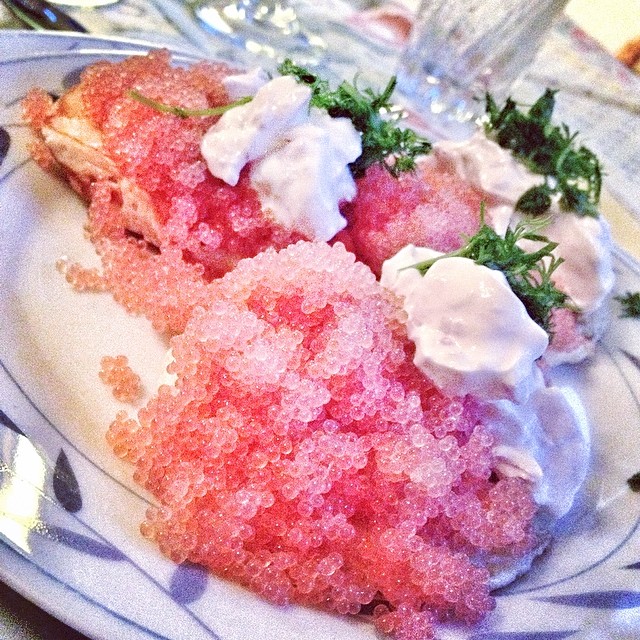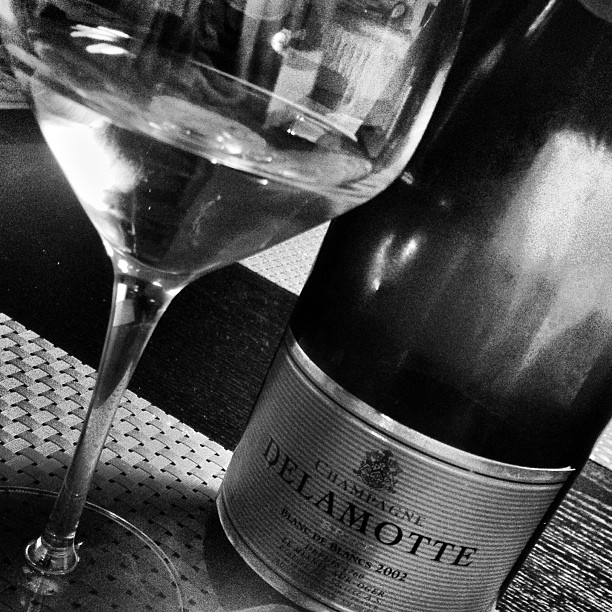Over the last couple of years, an exciting trend has been spreading amongst people in the foodie world. So-called locavores have emerged. That is, people who strive to eat locally produced foods and usually also strive for fresh and seasonal items in their diets. Funny, isn’t it? Only in a world that has been moving too fast for too long and seen too many side effects of globalization (good or bad), can something that seemed natural 50 years ago seem like a new and exciting trend today. Ahem, but that’s not to say I’m not a fan and that I don’t try to eat locally produced foods whenever I can.
The trouble with being Danish and eating locally, eating fresh and eating in season has to do with a little something called winter. A period where nothing much really grows this relatively far up North. As it is, we’re still only just escaping the clutches of winter and, well, not a hell of a lot of exciting things are in season right now. We’re still holding our breath for spring, baby greens, asparagus, lettuce, herbs and, eventually, homegrown vegetables and all that jazz… While we’re waiting patiently for all of that to happen, we’re stuck on a protein rich diet of dairy, meat and root vegetables. But speaking of protein, we do have one sure-fire indicator of spring. One new and exciting thing that’s just come into season. And by thing I mean fish and by in season I mean with roe. One thing that has Danes across the nation; hipsters, bloggers, housewives, kids and the elderly alike going crazy. And that thing, my friends, is the humble lumpfish. A fish that is every bit as ugly as it is highly priced amongst Danes, mainly for its roe.
Who’s a pretty fishy? Not you, lumpfish! Photo credit: @mikayleo on instagram.com
It’s odd, really, that lumpfish roe, as unbelievably fresh and tasty as it is, has become such a big thing for us. I remember eating this with great pleasure one or two decades ago, then it all but disappeared for a while during the turbulent years at the leading into the new millennium, only to come charging back now with a vengeance after NOMA and a few other things happened that helped put focus back on Danish and Nordic ingredients as opposed to pricier and, till then, posher imports. And now again, lumpfish roe, in the few short months between January and April where it’s usually in season, has become highly sought after as a fine, crisp, tasty subtle and, well, substantially cheaper alternative to the posh, majestic and ridiculously expensive Caviar.
Lumpfish roe! If you look carefully, there are actually a few blinis underneath!
As a result, every Danish food blog is currently churning out lumpfish roe recipes left and right. As I’m certainly always was up for jumping the bandwagon a little late and chiming in, I thought that I, too, would chime in with a tribute to the luscious seafood snack and bringer of spring that is lumpfish roe. Unfortunately, on the subject of lumpfish roe, if you’re looking for something extravagant from my hands, I am sorry to disappoint you (for once!). As much as I love to overly complicate almost everything, my all time favorite lumpfish roe recipe is really more a non-recipe!
The taste of lumpfish roe: So, what’s the deal with lumpfish roe? Well, it’s hard to explain, really. If treated properly, lumpfish roe will have much the same mouthfeel as genuine caviar. That is, little firm beads that give way and pop to the force of your teeth. They do, however, lack some of the intensity and more pronounced flavors of genuine caviar. That is to say, they’re in a way oddly mild and somewhat tasteless, but in an absolutely seductive and unique manner. There’s a distinct saltiness, a unique freshness and a sea-like quality to them with the faintest hint of fish. They’re like little exploding beads of seductive freshness, eaten more for their freshness, texture and explosive pop than their explosive flavor.
The thing is, I like my roe as I like my caviar: plain and simple with a bit of salt on a warm home-made blinis with a side of cremefraiche and possibly a shot of quality Russian vodka. The company of one or more beautiful women would, naturally, be very much appreciated as well. That’s, quite simply, how I roe roll and that’s how I’d suggest you should roll, too. Especially if you’ve never really had roe before.
Blinis or blini, I’m still getting my grasp on Russian grammar, are small, savory buckwheat pancakes that are traditionally made with a leavening agent (yeast) and left to rise before baking. Baking remains the traditional term for blini(s) cooking even though today they’re cooked in a pan like pancakes and not in the oven as in the old days. The addition of yeast make the blinis light and airy despite the use of buckwheat in the batter. Buckwheat, on the other hand, make blinis more flavorful than regular pancakes
In keeping with tradition, finely diced red onion is another traditional garnish for blinis, but I tend to go easy on the onion. Roe, lumpfish roe in particular, has a very subtle, clean, salty ocean-like flavor that the raw bite of the onion will just flat out run over and tear apart. If you use onion, I advise you do so sparingly. You may even consider blanching the onion for a brief few seconds in boiling water just to take the raw bite off. Just dump diced onions in rapidly boiling water and drain immediately, then rinse and keep in ice water till needed. You’ll be glad you did.
A bottle of 2002 Delamotte BdB would be a perfectly acceptable sidedish for lumpfish roe!
Don’t like vodka? Fear not, there are so many other great pairings for blinis with roe. Try a nice, young, crisp and slightly fruity white wine. Possibly an Alsatian Riesling from the upper end of the scale. My good friend Zascha might suggest a fine, mellow Sauvignon Blanc from Sancerre and while we may fight like cats and dogs on some issues, this choice wouldn’t be one of them. Or, heck, try a good Chardonnay. It doesn’t have to be from Burgundy, but I would keep it old world. New world Chardonnays are, by and large and very generally speaking, kind of oaky and jammy. If, on the subject of Chardonnay, you are feeling particularly generous and actually do happen to find yourself in the company of one or more of the above-mentioned beautiful women, a good bottle of Blanc de Blancs Champagne is pretty much mandatory. I’m sorry, I don’t make the rules. Go on, live a little!
But before you pop the Champagne, take a bit of time out of your busy schedule to bake these world-class blinis, then top them with a bit of creme fraiche, a light sprinkle of onion and as much roe as you can possibly afford or stomach. If lumpfish is not available in your neck of the woods on your side of the pond, there are plenty of other options. Both trout roe and salmon roe are delicious but also larger, sweeter and in my mind mouth a little more fishy. If you’re Japanese (or stuck in a sushi bar or ethnic store) tobiko, that is flying fish roe, would certainly do. If you’re feeling decidedly decadent (and wealthy) nothing beats the real thing, Real Caspian Sea Caviar from the mighty sturgeon is a meal fit for kings and queens, a meal that will set you back a small fortune, and meal that will stick with you as one of your greatest dining experiences ever… But that’s another post and an entirely different price tag altogether.
Whatever you do, please consider this for your next dinner or cocktail party hors d’oeuvres. ‘Tis, after all, the season!

Buckwheat Blinis
Ingredients
- 175 grams of regular baking flour
- 60 grams of buckwheat flour
- 1 teaspoon of salt
- 4 teaspoons of dry yeast
- 200 milliliters of whole milk
- 2 eggs separated
- 200 milliliters of creme fraiche 18% fat
- 50 grams of butter melted (for cooking)
Instructions
-
Sift regular flour into a large bowl
-
Mix in buckwheat flour, salt and dry yeast
-
Heat milk in a casserole over low heat until slightly warm, mix with creme fraiche and egg yolks.
-
Whisk milk mixture into the flour and continue whisking till fairly smooth
-
Cover bowl and allow to rest in the fridge for about an hour
-
Whisk egg whites to the stiff peaks stage and gently fold them into the blinis batter
-
Cover bowl back up and allow to rest in the fridge for another hour
Cooking:
-
Expect to be able to cook about four blinis at a time.
-
Heat a pan over medium heat, add four small dollops of melted butter to the pan, one per blini, followed by about 50 milliliters of dough on top of each dollop of butter.
-
Cook blinis for about two minutes on one side, flip then cook another two minutes on the other side. Repeat till no batter is left.
Recipe Notes
If you're not a fan of dry yeast, you can substitute 50 grams of a cake yeast. In this case, the yeast should be dissolved in the warm milk before mixing with the other ingredients.
As far as baking cooking goes, you can cook your blinis about four at a time using either a special blinis pan or a regular non-stick pan. The dough is so thick and compact that it will make pretty nice and round little pancakes even without the use of special pan. So really, a blinis pan is a bit of a waste unless you get particularly obsessed with perfectly round pancakes, in which case you may consider seeking professional help. You can keep already baked blinis warm in a low oven while you finish the entire batch.
When you’re ready to serve, top each blinis with a dollop of sour cream, a spoonful of roe, a light sprinkle of finely diced red onion and a sprig of dill, then serve immediately and plentifully to hungry diners with your crisp beverage of choice. That, my friends, is simple, decadent and affordable luxury at its very best!
What? Feeling squeamish? Look, I can’t really blame you. I realize that piling fresh, raw fish eggs in your mouth might not seem like a totally reasonable (let alone sane) thing to do for some people. Really, what have you got to lose? As with so many other things in the culinary world: What’s the absolute worst thing that can happen? That you won’t like it and will never eat it again? And what’s the best thing that can happen? That you’ll have found a new favorite food and start wondering why you wasted years of your life going “Goodness, the things some people will put in their mouths!” … Seems worth the risk to me!



Lumpfish roe is affordable and a 2 oz. jar of Roland-brand black or red lumpfish “caviar” costs only about $ 6.99. You treat it as expensive real caviar and it is a real treat !Makes a fine Brunch food; served with smoked salmon, toasted bagels, or heart rye bread, cream cheese, olives, baby pickles, scallions, sliced ripe tomatoes and red onions and a good piece of sharp cheese…with spicy bloody Mary’s or screw-drivers. Dazzle your guests on Sunday morning for breakfast or a Saturday early-afternoon brunch.They will think you went all out…and it is so simple and easy to prepare and costs no more than buying cold-cuts for sandwiches.Try it !